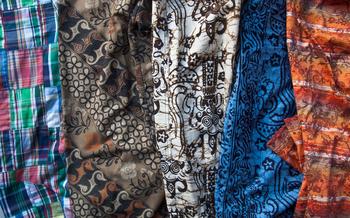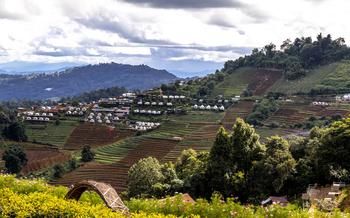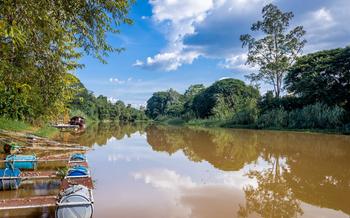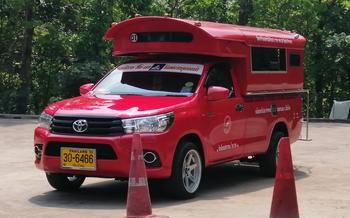
Wat Phra That Doi Suthep
- Wat Phra That Doi Suthep: A Sacred Mountaintop Temple
- Pilgrimage to the Temple
- Exploring the Temple Grounds
- Paying Respect to the Emerald Buddha Replica
- Wat Phra That Doi Suthep's Unique Architectural Style
- The Legend of the White Elephant
- Festivals and Events at Wat Phra That Doi Suthep
- The Temple's Role in the Local Community
- Getting to Wat Phra That Doi Suthep
- The Best Time to Visit
- Where to Stay Nearby
- What to Eat and Drink
- Souvenirs and Shopping
- Insider Tip: Hidden Gems
Wat Phra That Doi Suthep: A Sacred Mountaintop Temple
Nestled atop Doi Suthep Mountain, overlooking the vibrant city of Chiang Mai, lies the revered Wat Phra That Doi Suthep, a sacred temple that holds immense religious and cultural significance in Thailand. The temple's origins date back to the 14th century, when a white elephant carrying a holy relic of the Buddha chose the mountaintop as its resting place, leading to the construction of the temple. Throughout the centuries, Wat Phra That Doi Suthep has become a revered pilgrimage site, attracting devout Buddhists and visitors from around the world.
The temple's architectural design showcases a blend of Lanna and Burmese styles, characterized by intricate carvings, stupas, and spires adorned with gold leaf and colorful tiles. Its majestic chedi, the main stupa, rises prominently, symbolizing the Buddha's enlightenment and serving as a focal point of worship. The temple complex also houses several Buddha images and relics, including a replica of the revered Emerald Buddha, which is believed to possess sacred powers and draws countless devotees.
Pilgrimage to the Temple
Wat Phra That Doi Suthep holds immense significance as a pilgrimage site for devout Buddhists and pilgrims from around the world. The sacred staircase leading up to the temple is a symbolic journey, representing the spiritual ascent towards enlightenment. Each step is believed to purify the soul and bring the pilgrim closer to the divine.
Devotees often make offerings of flowers, incense, and candles at the temple's many shrines, seeking blessings and expressing their gratitude. The temple also hosts several festivals and ceremonies throughout the year, attracting large crowds of worshipers. During these special occasions, the temple grounds come alive with vibrant processions, traditional music, and heartfelt prayers.
One of the most significant rituals performed at the temple is the bathing of the Emerald Buddha replica. This sacred ceremony takes place annually and involves pouring lustral water over the revered Buddha image, symbolizing purification and renewal. The water is believed to be imbued with blessings and is often collected by devotees as a symbol of good fortune.
Exploring the Temple Grounds
Within the expansive grounds of Wat Phra That Doi Suthep, a wealth of sacred structures and significant features await exploration. One of the most revered sites is the Grand Pagoda, a towering golden chedi that stands as the temple's centerpiece. Its intricate design and shimmering spires symbolize the pinnacle of Lanna architecture.
As you wander through the temple complex, you'll encounter numerous Buddha images, each exuding a distinct aura of serenity and reverence. Among them, the Phra Buddha Sihing holds a special place in the hearts of devotees. Believed to date back to the 9th century, this revered image is enshrined within a grand pavilion and draws countless pilgrims seeking blessings and spiritual guidance.
Several sacred chedis, or stupas, are scattered throughout the temple grounds, each representing a significant event or figure in Buddhist history. The Chedi Luang, the oldest chedi in the complex, is a majestic sight with its towering height and intricate carvings. These chedis serve as reminders of the temple's rich heritage and the enduring legacy of Buddhism in Thailand.
Gardens and ponds add to the tranquility of the temple grounds, creating a serene atmosphere conducive to contemplation and reflection. The Sacred Pond, located at the foot of the Grand Pagoda, is believed to possess mystical powers, and devotees often make offerings to the water spirits residing within.
Paying Respect to the Emerald Buddha Replica
The Emerald Buddha, enshrined at Wat Phra Kaew in Bangkok, is considered the most sacred image in Thailand. While the original Emerald Buddha remains in Bangkok, Wat Phra That Doi Suthep houses a revered replica that attracts countless devotees. This replica, crafted with exquisite craftsmanship, embodies the same spiritual significance as the original.
Devotees flock to the temple to pay homage to the Emerald Buddha replica, seeking blessings, making offerings, and praying for good fortune. The rituals and offerings performed here reflect the deep devotion and reverence held by Thai people for this sacred image.
One of the most common offerings is gold leaf, which devotees apply to the Buddha statue as a symbol of merit-making. The act of applying gold leaf is believed to bring good luck, prosperity, and protection. Devotees also make offerings of flowers, candles, and incense, expressing their gratitude and seeking spiritual guidance.
The belief in the protective powers of the Emerald Buddha is deeply ingrained in Thai culture. Many Thais believe that the Buddha statue possesses the ability to bestow blessings, ward off evil, and bring harmony and peace to the land. This belief has contributed to the enduring popularity of Wat Phra That Doi Suthep as a pilgrimage site, where devotees come to seek solace, guidance, and blessings from the revered Emerald Buddha.
Wat Phra That Doi Suthep's Unique Architectural Style
Wat Phra That Doi Suthep stands out for its exquisite architectural style, a blend of Lanna and Thai influences. The temple's design incorporates intricate carvings, stupas, and spires, showcasing the craftsmanship and artistry of Lanna artisans. The use of gold leaf and colorful tiles adds to the temple's grandeur, creating a visually stunning masterpiece. The harmonious fusion of religious and artistic elements reflects the deep connection between spirituality and aesthetics in Thai culture.
The Lanna architectural style, prevalent in northern Thailand, is characterized by its elegant lines, graceful curves, and intricate details. The temple's wooden structures, such as the viharn (assembly hall) and the mondop (reliquary), showcase the skillful woodworking techniques of Lanna craftsmen. The sweeping roofs, adorned with intricate carvings and colorful tiles, are a testament to the region's rich artistic heritage.
The use of gold leaf further enhances the temple's opulence and sacredness. The gleaming golden stupas, spires, and Buddha images exude an aura of divinity, symbolizing the temple's importance as a place of worship and pilgrimage.
The harmonious blend of religious and artistic elements is evident throughout the temple grounds. The sacred chedis, housing relics of the Buddha, are adorned with intricate carvings depicting scenes from Buddhist mythology. The surrounding gardens, ponds, and sculptures create a serene and contemplative atmosphere, inviting visitors to immerse themselves in the temple's spiritual essence.
The Legend of the White Elephant
Legends and myths are an integral part of Thailand's rich cultural heritage, and Wat Phra That Doi Suthep has its own captivating legend that involves a majestic white elephant. According to local lore, a white elephant miraculously appeared to King Ku Na of the Lanna Kingdom in the 14th century. The elephant carried a holy relic, a fragment of the Buddha's shoulder bone, and it was believed that wherever the elephant knelt, a temple should be built to enshrine the relic.
The white elephant led a procession from the city of Chiang Mai up the slopes of Doi Suthep Mountain, stopping at various points along the way. At each stop, the elephant knelt, indicating the locations where smaller temples should be constructed. Finally, the elephant reached the summit of Doi Suthep, where it knelt for the last time, and the main temple, Wat Phra That Doi Suthep, was built on that sacred spot.
The white elephant holds a significant place in Thai mythology as a symbol of royalty, strength, and good fortune. It is believed that the elephant's appearance was a sign of divine intervention, guiding the king and his people to the most auspicious location for the temple. The presence of elephant motifs and sculptures throughout the temple complex serves as a reminder of this legendary creature and its role in the temple's foundation.
Festivals and Events at Wat Phra That Doi Suthep
Wat Phra That Doi Suthep is not just a place of worship but also a vibrant center for cultural and religious festivals. Throughout the year, the temple hosts a variety of events that attract both locals and tourists.
One of the most significant festivals is Songkran, the Thai New Year, which takes place in mid-April. During Songkran, the temple grounds come alive with colorful processions, traditional dances, and water-throwing activities. Devotees also make merit by pouring water over Buddha images and offering food to monks.
Another popular festival is Loy Krathong and Yi Peng, which is celebrated in November. During this festival, people release floating lanterns into the sky and float decorated krathongs (lotus-shaped boats) on the temple's pond. The sight of hundreds of lanterns illuminating the night sky is truly magical.
Visakha Bucha, the most important Buddhist festival, is also celebrated with great devotion at Wat Phra That Doi Suthep. On this day, which commemorates the birth, enlightenment, and passing of Buddha, devotees gather at the temple to offer prayers, make merit, and listen to dharma teachings.
In addition to these major festivals, Wat Phra That Doi Suthep also hosts various other events throughout the year, such as meditation retreats, ordination ceremonies, and traditional Thai dance performances. These events provide visitors with an opportunity to immerse themselves in the temple's rich cultural and spiritual traditions.
The Temple's Role in the Local Community
Wat Phra That Doi Suthep plays a multifaceted role in the local community, extending beyond its religious significance. The temple serves as a hub for various community activities and initiatives, fostering a sense of unity and social cohesion. Monks and volunteers at the temple actively participate in educational and social development programs, contributing to the well-being of the surrounding communities. The temple also serves as a cultural center, preserving local traditions and heritage through events, festivals, and teachings. Its involvement in community development initiatives, such as education, healthcare, and environmental conservation, has earned it the respect and admiration of the local population. The temple's presence has had a profound impact on the social fabric of the region, promoting harmony, cooperation, and a strong sense of community spirit.
Getting to Wat Phra That Doi Suthep
Transportation options from Chiang Mai to the temple
Reaching Wat Phra That Doi Suthep from Chiang Mai is a scenic and convenient journey. Several transportation options are available to suit different preferences and budgets.
-
Songthaew (Shared Taxi): Affordable and widely used, songthaews can be hailed from the city center or Chang Puak Gate. The fare is typically around 40-60 baht per person.
-
Tuk-Tuk: A fun and adventurous way to travel, tuk-tuks offer a personalized experience. Negotiate the price before your ride, which usually ranges from 200 to 300 baht.
-
Taxi: Taxis are readily available and provide a comfortable journey to the temple. Fares typically start from 300 baht and can vary depending on the distance and traffic conditions.
-
Organized Tours: Many tour operators in Chiang Mai offer guided tours to Wat Phra That Doi Suthep. These tours often include transportation, a knowledgeable guide, and visits to other attractions in the area.
The scenic drive up Doi Suthep Mountain
The drive up Doi Suthep Mountain offers breathtaking views of the surrounding countryside. The winding road takes you through lush forests, past cascading waterfalls, and stunning viewpoints. Along the way, you may encounter friendly locals selling handmade crafts and souvenirs.
The availability of tour packages and guided tours
For those who prefer a hassle-free experience, numerous tour packages and guided tours are available. These tours typically include transportation, entrance fees, and the services of an experienced guide who can provide insights into the temple's history, culture, and significance.
Tips for planning a hassle-free visit
- Plan your visit early in the morning or late afternoon to avoid the midday heat and crowds.
- Wear comfortable shoes as you'll be doing some walking on uneven surfaces.
- Be respectful of the temple's sacredness by dressing appropriately and observing local customs.
- Bring water and sunscreen, especially if you're visiting during the hot season.
- Allow ample time to explore the temple grounds and enjoy the serene atmosphere.
The Best Time to Visit
Deciding when to embark on your pilgrimage to Wat Phra That Doi Suthep is crucial for maximizing your experience. The cool season, which runs from November to February, offers ideal weather conditions for exploring the temple grounds. During this time, the skies are clear, the air is crisp, and the temperatures are pleasant, making it perfect for strolling through the temple complex and soaking in the panoramic views.
However, if you seek a more vibrant and festive atmosphere, plan your visit to coincide with one of the temple's many festivals and special events. Songkran, the Thai New Year celebration in April, transforms the temple grounds into a lively spectacle, with water splashing, colorful parades, and traditional performances. Loy Krathong and Yi Peng in November are equally captivating, with thousands of lanterns illuminating the night sky and creating a magical ambiance.
To avoid the crowds and ensure a more peaceful visit, consider visiting during the shoulder seasons (March-April and September-October) or on weekdays instead of weekends. This will allow you to fully appreciate the temple's serenity and immerse yourself in its spiritual atmosphere without the hustle and bustle of large tour groups.
Where to Stay Nearby
When planning your pilgrimage to Wat Phra That Doi Suthep, finding a suitable place to stay is essential to making the most of your experience. The area surrounding the temple offers diverse accommodation options, ranging from simple guesthouses to luxurious resorts.
If you're a budget traveler or seeking a more authentic experience, consider staying at one of the many guesthouses or homestays in the vicinity of the temple. These cozy accommodations provide a comfortable and affordable stay, allowing you to immerse yourself in the local culture.
For those seeking a more upscale experience, several hotels and resorts offer stunning views of the mountain and the temple. These accommodations provide luxurious amenities and facilities, ensuring a relaxing and memorable stay.
No matter your budget or preferences, staying near Wat Phra That Doi Suthep allows for easy access to the temple and its surroundings, enabling you to fully explore this sacred and serene destination.
What to Eat and Drink
After exploring the sacred grounds of Wat Phra That Doi Suthep, indulge in the culinary delights that surround the temple. The area is a haven for food enthusiasts, offering a diverse range of local cuisine and regional specialties.
Popular street food stalls and restaurants line the streets leading to the temple, tempting visitors with their mouthwatering aromas. Savor the flavors of traditional Thai dishes such as khao soi, a rich and flavorful curry noodle soup, or sai ua, a succulent grilled sausage made with lemongrass, galangal, and turmeric.
Don't miss the opportunity to sample local delicacies like khanom jeen nam ngiao, a fermented rice noodle dish served with a spicy northern Thai curry, or gaeng hang lay, a mild curry made with pork belly, ginger, and tomatoes.
For a refreshing treat, try the sweet and tangy nam dok anchan, a butterfly pea flower drink, or quench your thirst with a cold cha yen, a Thai iced tea.
Remember to embrace the local culinary culture by trying new dishes, asking questions about ingredients, and supporting local vendors. Your taste buds will thank you for the adventure!
Souvenirs and Shopping
At Wat Phra That Doi Suthep, visitors can find a vibrant collection of stalls and shops offering a wide range of souvenirs, handicrafts, and religious items. These stalls are conveniently located near the temple's entrance, making it easy for visitors to browse and purchase mementos of their visit.
When shopping at Wat Phra That Doi Suthep, bargaining is not only acceptable but also expected. Vendors are generally open to negotiating prices, and visitors can often score great deals by using their bargaining skills. However, it's important to be respectful and friendly during the bargaining process.
For those looking for unique souvenirs, there are plenty of handmade items and local crafts to choose from. Visitors can find intricately carved wooden sculptures, colorful hand-painted ceramics, and delicate silk scarves, all made by local artisans.
By purchasing souvenirs from Wat Phra That Doi Suthep, visitors not only take home a piece of the temple's charm but also support the local community. The income generated from these sales directly benefits the temple and helps to fund its ongoing maintenance and preservation.
Here's a tip: If you're looking for a truly unique souvenir, consider purchasing a miniature replica of the Emerald Buddha. These replicas are handcrafted by local artisans and are a beautiful way to remember your visit to Wat Phra That Doi Suthep.
Insider Tip: Hidden Gems
Beyond the main attractions at Wat Phra That Doi Suthep, there are hidden gems waiting to be discovered. One such gem is the Monk's Trail, a serene hiking trail that leads through the lush forest surrounding the temple. Embark on this peaceful walk to connect with nature and find tranquility amidst the tranquil surroundings.
Another hidden treasure is Wat Pha Lat, a neighboring temple known for its unique reclining Buddha. This serene and less-visited temple offers a glimpse into the region's rich Buddhist heritage. Take some time to explore its grounds and admire the intricate carvings that adorn this hidden sanctuary.
For those seeking breathtaking views, venture to the lesser-known viewpoints around Wat Phra That Doi Suthep. These secluded spots offer panoramic vistas of the surrounding mountains, providing a unique perspective of the temple's stunning location. Embrace the tranquility of these hidden gems and capture unforgettable memories of your journey to Wat Phra That Doi Suthep.




